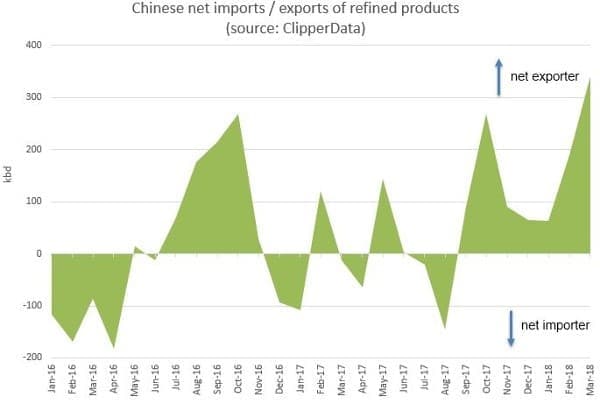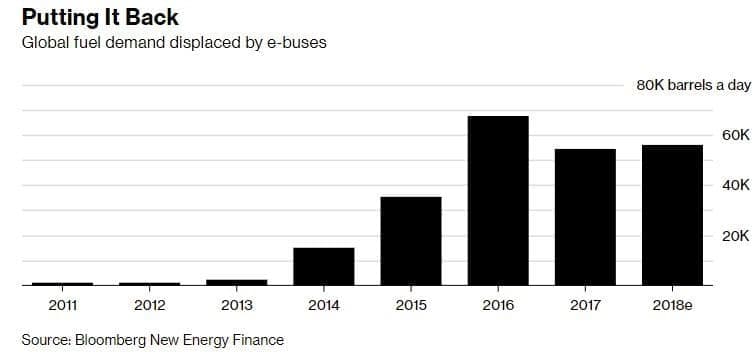A Bloomberg article about electric buses in China is getting a good amount of mileage (sorry), and rightly so, given its detrimental impact on product demand (hark, ~70kbd this year). While China increases its focus on electric vehicles and takes aim at fuel emissions, it is also becoming a bigger player in the global fuels market, as exports increase amid higher domestic refining activity.
China has been a net exporter of refined products for the past seven consecutive months, with a record pace of refinery runs leaving more available for export.
Here at the good ship Clipper, we have a partnership with Ursa, combining our flows data and their monitoring of inventories via satellite imagery to estimate Chinese refinery runs. We saw refinery runs hitting a record last month, and correspondingly net exports also reached a record:

(Click to enlarge)
Subsequently, official Chinese data affirmed this record pace; based on our data, we expect April's rate to be similarly impressive.
The vast majority of product exports (~85 percent) remain within Asia, but we are seeing consistent deliveries further afield. The U.S. is one such destination, with jet fuel delivered to the U.S. West Coast in twelve of the last sixteen months. Deliveries to the Atlantic Coast are more rare, but we have seen a few deliveries of kerosene.
Our ClipperData show that the vast majority of Chinese refined products into the U.S. are middle distillates, although 302,000 bbls of CBOB was discharged at BP's Portland terminal in Oregon late last month.

(Click to enlarge)
While refining activity and product exports rise, China is increasingly trying to keep domestic fuel emissions at bay. This recent article from The Economist highlights one way the Chinese government is using to cut down on pollution: license plates.
License plate lotteries exist across a number of Chinese cities, aimed at reining in both pollution and congestion. But the odds ain't good. In Beijing, the chance of winning one of the bi-monthly lotteries has dropped from 6 percent in 2011 to just 0.2 percent this year, given rising participation. Related: China’s Oil Futures Are Gaining Momentum
Shanghai has been particularly shrewd, splitting its license plate allocations betwixt a lottery and an online auction. The city raised 12 billion yuan from auctions last year - accounting for 2 percent of its total revenues. With winning bids averaging 88,176 yuan ($14,022), in some instances, license plates ended up costing more than the cars themselves.

Back to them buses, and it is estimated that electric buses are displacing around 70,000 bpd of global fuel demand this year, with that number set to rise in the coming years as the fleet grows.
China is leading the charge, accounting for about 99 percent of the 385,000 electric buses on the roads worldwide last year. Chinese cities are adding 9,500 buses every five weeks, the equivalent of London’s entire working fleet. Given the buses consume ~30 times more fuel than a car, their impact on fuel demand is much greater than individual vehicles.
On this basis, electrification of the transportation sector is going to continue nibbling away at global product demand, taking increasingly bigger bites.

(Click to enlarge)
By Matt Smith
More Top Reads From Oilprice.com:
- The Top Natural Gas Players In 2018
- The Biggest Challenge In Electric Car Markets
- The Overstated Threat Of High Oil Prices



















9,500 new busses every 5 weeks is 1,900 a week or about 271 a day. Sounds huge but I guess is believable. The 30 to 1 ratio of fuel usage to cars is very interesting.
Thanks Matt!
Seems very similar to the oil industry of today. Story after story talks about electric vehicles used to achieve reduced emissions. You would think that the oil industry would be listening. But they are Not.
Their Captain, Scott Pruitt at the EPA, is ordering "Full Speed Ahead" for dirty fuels, by handing out waivers to refiners to ignore ethanol. Ethanol reduces auto emissions, but Pruitt doesn't care. Its full speed ahead with dirty benzene laced fuels.
Who's afraid of a few icebergs?